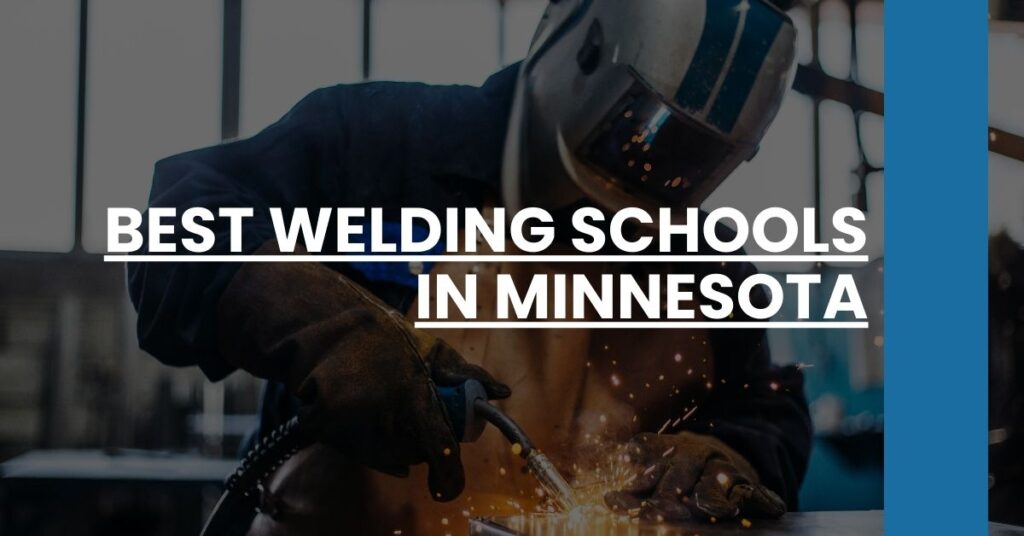Looking for schools in a specific city? Check out our lists of Welding Schools in Minneapolis, St. Paul, and Rochester.
So you’ve decided to pursue a career in welding, and now you’re looking for the best welding schools in Minnesota. That’s a smart move given the robust job market and competitive wages for skilled welders in the state.
Our team understands how crucial it is to choose the right school to set the foundation for your future career. That’s why we’ve put together a guide to help you navigate this important decision.
In this guide, you’ll find:
- A list of the best welding schools in Minnesota
- Detailed information on what makes these schools stand out
- Insight into specialized programs and certifications offered by these schools
- Why Become a Welder in Minnesota
- Criteria for Choosing a Welding School
- Top-Ranked Welding Schools in Minnesota
- Specialized Welding Programs and Certifications Offered
- Campus Facilities and Hands-On Training Opportunities
- Financial Aid and Scholarships for Welding Students
- Career Services and Job Placement Support
- Alumni Success Stories
- How to Apply to Welding Schools in Minnesota
- Looking for Welding School Information On States Bordering Minnesota?
- Conclusion
Why Become a Welder in Minnesota
Job Prospects and Demand
Minnesota’s industrial landscape ensures a steady demand for skilled welders. According to the U.S. Bureau of Labor Statistics, the state continues to see growth in manufacturing, construction, and repair services. This diverse industrial base drives a consistent need for welding professionals.
For those entering the field, this translates into strong job prospects. The Minnesota Department of Employment and Economic Development underscores the regional need for welders, suggesting ample opportunities for employment upon completing your training.
Competitive Earnings
Welders in Minnesota can expect competitive salaries. The median annual wage stands at $46,000, with experienced professionals earning upwards of $60,000 annually. This financial stability, coupled with the strong demand for welders, makes the field particularly appealing for those looking to build a reliable and rewarding career.
Additional Benefits
- Job Stability: Given the steady regional demand, welding offers a secure career path.
- Diverse Opportunities: Work across various sectors, including manufacturing, construction, and custom fabrication.
- Potential for Advancement: Advanced skills and certifications can lead to higher-paying positions and specialized roles.
Criteria for Choosing a Welding School
Accreditation
When selecting a welding school, ensure the program is accredited by reputable organizations such as the National Institute for Metalworking Skills (NIMS) or the American Welding Society (AWS). Accreditation guarantees you’ll receive a quality education that meets industry standards.
Comprehensive Curriculum
A robust curriculum is essential. Look for programs that offer training in multiple welding techniques, including:
- MIG Welding
- TIG Welding
- Arc Welding
Verify that the curriculum covers safety protocols and offers ample hands-on practice.
Experienced Faculty
The quality of instruction is critical. Ensure the faculty members are industry professionals with relevant certifications. Instructors with real-world experience can provide practical insights and training that textbooks alone cannot offer.
Modern Facilities
Top-tier facilities are a must. Schools equipped with industry-standard welding machines and tools better prepare you for real-world applications. Modern labs and workshops enable you to gain hands-on experience with the equipment you’ll use in your career.
Industry Partnerships
Schools with strong ties to local industries can offer valuable internship and apprenticeship opportunities. These connections also enhance job placement services, making it easier for you to transition into the workforce upon graduation.
Top-Ranked Welding Schools in Minnesota
Dunwoody College of Technology
Dunwoody College of Technology is renowned for its Welding & Metal Fabrication program. It’s accredited by NIMS and boasts a 100% job placement rate. This program offers cutting-edge training, preparing students thoroughly for their welding careers.
Minnesota State College Southeast
Minnesota State College Southeast offers both a Welding Technology Diploma and Certificate. These programs provide extensive training in various welding techniques, including Oxy-fuel, MIG, TIG, and Stick welding. The college also offers robust career services to support graduates in finding employment.
Lynnes Welding Training School
Lynnes Welding Training School is known for its exceptional MIG welding classes. The experienced instructors emphasize hands-on practice and real-world applications, ensuring that students are well-prepared for the demands of the industry.
South Central College
South Central College offers a comprehensive welding curriculum tailored to meet industry needs. The program includes certifications and training in advanced welding techniques, making it an excellent choice for those looking to specialize.
Specialized Welding Programs and Certifications Offered
Certifications for Career Advancement
Certifications can significantly enhance your employability and potential earnings. Look for programs offering certifications in essential welding techniques:
- MIG Welding: Dunwoody College of Technology offers specialized courses in MIG welding and robotic welding.
- TIG Welding: South Central College provides advanced certifications focusing on high-pressure piping and production welding.
- Stick Welding: Minnesota State College Southeast includes Stick welding in its comprehensive Welding Skills Lab curriculum.
Niche and Advanced Techniques
Some schools offer training in niche areas like:
- Robotic Welding: Available at Dunwoody College of Technology, this course prepares you for the future of automated welding.
- Custom Fabrication: Learn about customized welding techniques for various industry needs, which can be particularly lucrative specialty areas.
Campus Facilities and Hands-On Training Opportunities
Dunwoody College of Technology
At Dunwoody College of Technology, students benefit from a state-of-the-art welding shop and manufacturing innovation lab. The lab is equipped with modern welding machines and tools, offering hands-on experience from the start. This practical training environment is crucial for mastering the skills needed in a professional setting.
Minnesota State College Southeast
Minnesota State College Southeast provides students with extensive hands-on learning opportunities. Their dedicated welding lab is open from day one, focusing on safety, blueprint reading, and project-based learning. This ensures that students are not only technically proficient but also understand the theoretical aspects of welding.
Lynnes Welding Training School
Lynnes Welding Training School emphasizes ample hands-on welding time. The school’s facilities are fully equipped with industry-standard machines and tools. Experienced instructors guide students through practical applications, making the learning process both engaging and effective.
South Central College
South Central College offers a blend of modern facilities and experienced faculty to provide a comprehensive learning experience. The school’s welding labs are equipped to handle a variety of welding techniques, preparing students for the diverse demands of the industry.
Financial Aid and Scholarships for Welding Students
Scholarships and Grants for Aspiring Welders
Pursuing a welding career can be financially manageable with the right resources. Many welding schools in Minnesota offer a range of scholarships and grants designed to support students.
- Minnesota Future Together Grants: This program provides financial aid for students enrolling in public institutions in high-need career areas, including welding. Eligible students can often benefit from tuition-free pathways, significantly reducing the financial burden.
- Dunwoody College of Technology: Offers access to various federal and state financial aid programs. They also provide specific scholarships for students in their technical programs, which can help make your education more affordable.
- Minnesota State College Southeast: Has a comprehensive array of scholarships and grants aimed at students in welding and other technical programs. Their financial aid office is a valuable resource for identifying and securing financial support.
Applying for Financial Aid
Navigating the financial aid process can sometimes feel overwhelming, but most schools offer resources to help you. Start by filling out the Free Application for Federal Student Aid (FAFSA) to determine your eligibility for federal and state aid.
Tips for Successful Financial Aid Applications:
- Start Early: Submit your FAFSA as soon as possible to maximize your financial aid opportunities.
- Seek Guidance: Utilize school financial aid offices for support and advice on scholarships, grants, and loans.
- Research Options: Explore both school-specific and external scholarships applicable to welding programs.
Career Services and Job Placement Support
Job Placement Assistance
One of the critical factors that set top welding schools apart is their career services and job placement support.
- Dunwoody College of Technology: Boasts a 100% placement rate for its welding graduates. The school provides dedicated career services, job placement support, and strong industry connections. These services include resume building, interview preparation, and job search assistance.
- Minnesota State College Southeast: Offers comprehensive career services that help graduates transition smoothly into the workforce. This includes job search assistance, resume building workshops, and employer partnerships that facilitate quick job placements.
Internships and Apprenticeships
Real-world experience is invaluable. Many Minnesota welding schools have partnerships with local industries, offering students internship and apprenticeship opportunities.
Benefits of Internships and Apprenticeships:
- Practical Experience: Gain hands-on experience in a real-world setting, reinforcing the skills learned in class.
- Networking: Build professional connections with potential employers and industry leaders.
- Career Readiness: Develop a strong, practical understanding that makes you more marketable to employers upon graduation.
Alumni Success Stories
Real-World Impact
Alumni success stories offer tangible proof of the effectiveness of welding programs at Minnesota schools.
Example Success Stories:
- South Central College: Linsey Lawton completed her welding certification and diploma at SCC. She appreciates the supportive instructors and practical training she received. Now, she works in the welding industry while pursuing further education in the field, showcasing the program’s real-world impact.
- Minnesota State College Southeast: Graduates often quickly secure employment in diverse sectors like manufacturing, construction, and custom fabrication. Their success underscores the program’s efficacy in preparing students for various careers in welding.
Career Trajectories
The journeys of alumni also highlight the diverse career paths available to welding program graduates. Many find employment in high-demand industries, while others pursue advanced certifications and specialized roles.
Alumni Careers:
- Manufacturing and Production Welding: Employment in companies requiring large-scale welding operations.
- Construction Welding: Opportunities in building and infrastructure projects.
- Custom Fabrication: Roles in companies that create specialized or unique metal products.
How to Apply to Welding Schools in Minnesota
Step-by-Step Application Process
The application process for welding schools in Minnesota is straightforward, but it requires attention to detail.
Steps to Apply:
- Research Programs: Identify the welding programs that best suit your career goals.
- Fill Out Applications: Complete the application forms for each school. Pay close attention to deadlines and required documentation.
- Submit Transcripts and Recommendations: Gather and submit your high school transcripts and letters of recommendation if required.
- Schedule Visits: Plan visits to campuses to get a feel for the facilities and meet instructors.
- Apply for Financial Aid: Submit your FAFSA and explore available scholarships and grants.
Tips for a Successful Application
- Be Thorough: Ensure all parts of your application are complete and accurate.
- Follow Directions: Adhere to each school’s specific application guidelines and deadlines.
- Stay Organized: Keep track of application deadlines and required documents to avoid last-minute stress.
Looking for more Welder information? Check out our Certified Welding Inspector (CWI) practice test, find welding schools near you, learn how to become a welder, and explore options for welder certification.
Looking for Welding School Information On States Bordering Minnesota?
In addition to Minnesota, we suggest looking for schools in nearby states.
- Best Welding Schools In Wisconsin
- Best Welding Schools In Iowa
- Best Welding Schools In North Dakota
- Best Welding Schools In South Dakota
- Best Welding Schools In Michigan
Conclusion
Choosing to attend one of the best welding schools in Minnesota can set you on a path to a rewarding career. With strong job prospects, competitive salaries, and excellent educational programs, your investment in a welding education can pay off significantly. Explore your options, utilize available resources, and take the next step towards becoming a skilled welder.
For a comprehensive overview of top-rated welding schools in Minnesota, visit: Welder Schools in Minnesota.

